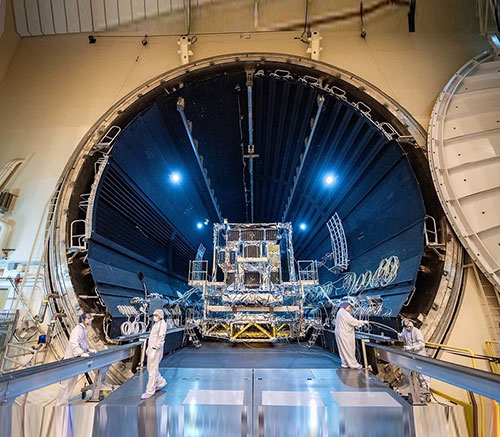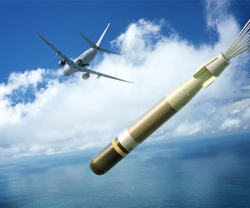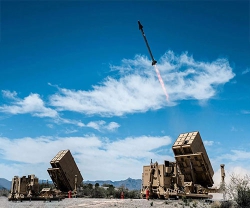The world’s most advanced missile defense satellite recently came out of almost two months of harsh simulated space environmental testing.
On June 9, the U.S. Space Force’s fifth Space Based Infrared System Geosynchronous Earth Orbit satellite (SBIRS GEO-5) successfully completed Thermal Vacuum (TVAC) testing at Lockheed Martin’s Sunnyvale, California satellite manufacturing facility.
Completing TVAC was a significant milestone for the first military space satellite to be built on one of Lockheed Martin’s modernized LM 2100™ satellite buses. During TVAC testing, the satellite – with its sophisticated electronics performing full operations – faced waves of heat and cold in a depressurized atmosphere similar to the drastic environmental changes experienced in space.
“The completion of TVAC can be attributed to a tremendous effort from the Air Force, Lockheed Martin, Aerospace Corporation, and supporting contractor teams,” said Tucker White, SBIRS GEO-5 Assembly, Test, and Launch Operations Lead from the Government Program Office.
“The teams worked around the clock and finished on schedule to their original projection. This test phase is vital to any space vehicle test regime and takes GEO-5 one step closer to providing enhanced missile detection to our warfighters,” he added.
SBIRS GEO-5 will join the Space Force’s constellation of missile warning satellites equipped, with powerful scanning and staring infrared surveillance sensors, which protect our nation 24-7. These sensors collect data that allow the U.S. military to detect missile launches, support ballistic missile defense, expand technical intelligence gathering and bolster situational awareness on the battlefield.
“In SBIRS GEO-5, and our next satellite GEO-6, we’re introducing game-changing enhancements to address the needs of our nation’s space warfighting force going forward,” said Tom McCormick, Vice President for Overhead Persistent Infrared (OPIR) Missions at Lockheed Martin Space. “The threat posed by ballistic missile technology continues to spread exponentially around the world. In 2019, SBIRS detected nearly a thousand missile launches globally, which is about a two-fold increase in two years.”
SBIRS GEO-5 is the first of two new SBIRS missile defense satellites and the fourth satellite built on Lockheed Martin’s new, modernized LM 2100 satellite bus. A major investment by Lockheed Martin, the LM 2100 purposefully focuses on increasing production speed, reducing costs, adding resiliency and building in more mission flexibility. The LM 2100:
- Drives efficiency and cost savings into satellite design and production by leveraging common components, processes and production practices across the entire satellite production line.
- Features 26 improvements that add more power and flexibility to the company’s proven A2100 satellite platform.
- Increases satellite resiliency, eliminates older components and utilizes modern electronics to add new capability and increase reliability.
- Offers a configurable payload module that provides more flexibility for military missions, accommodating mass, power, propellant and volume.
- Allows easy implementation of additional modernized sensor suites and mission payloads thru its modular design.
LM 2100 is currently slated to be the baseline bus of SBIRS GEO-5, and SBIRS GEO-6, expected to be launched in 2021 and 2022 respectively; three next Next Generation Overhead Persistent Infrared System (Next Gen OPIR) Block 0 GEO satellites expecting to launch starting in 2025; and the future GPS III Follow On (GPS IIIF) satellites, which are expected to launch starting in 2026.
The sophisticated SBIRS ground control system has had significant upgrades. SBIRS receives and processes large amounts of data from the global coverage of the satellites’ powerful sensors and converts this data into actionable reports for defense, intelligence and civil applications.




















